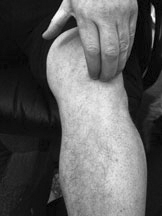At this point your condition is likely no longer tendonitis but tendonosis. I’m sorry to hear about your problem, as you’ve likely set yourself up for a very prolonged recovery.
I have tendonosis of my biceps tendon in my left shoulder from swimming. For a long time, I swam through it thinking it was an inflammatory condition. The reality is that I was repeatedly damaging the tendon, changing the characteristics of the tissue. I went to PT but they didn’t give me anything to treat the tendon itself… I did some research and found that a combination of friction massage, ice, and weight training have allowed me to get nearly pain free (after about 6 months of effort.)
In friction massage you basically strum across the tendon. If you are sore, this will probably be painful, but I found that pain would usually be decreased after massage. You’ll also need to do some stregnthening that targets the tendon. The rule of thumb I used was to do enough to feel some pain/soreness, but not so much that the pain could be felt the next day. This stimulates the tendon to grow stronger rather than to degenerate further.
I’m not a doctor or PT, but I have some experience with this type of issue and I’ve done some homework. If you’d like I can send you the article that really got me started on the way to recovery. PM me if interested.
For your information, here’s Knee Guru’s entry on patellar tendinitis that you might find helpful.
http://www.kneeguru.co.uk/html/steps/step_05_patella/tendinitis.html
Patellar tendinosis is a painful condition of the tendon below the kneecap, usually involving degeneration of the tendon substance. 
The condition used to be called patellar ‘tendinitis’ or ‘tendonitis’. The term ‘-itis’ in medicine means ‘inflammation’ - a process of irritation, increased blood supply, and infiltration of the area with special inflammatory cells - but these features are not actually seen in patellar tendinitis. So there is a lot of medical literature suggesting that the condition no longer be called ‘patellar tendinitis’ but ‘patellar tendinopathy’ or ‘patellar tendinosis’ instead, implying a degenerative condition rather than an inflammatory one. For your research, you need to search using all of these keywords.
In this disorder the tendon develops a mushy (‘mucoid’) degeneration, which weakens it, causes local discomfort, and may predispose the tendon to rupture.
It is a disabling condition which frequently affects sportspeople: mainly jumping sports insidious onset of pain localised to the area just under the kneecap painful when walking or running up slopes, or getting up from sitting tender to deep pressure underneath the kneecap Management of patellar tendinosis
The condition is hard to treat and frustrating for both patient and doctor. Although stopping the ‘overuse’ activitity is the best approach to arresting deterioration, this is often a major problem as it so often occurs in people who concentrate on a particular sport or activity and may earn their living from it, eg basketball or ballet. A local patellar strap worn during exercise is likely to be helpful (eg. ChoPat strap). Attention to the period of exercise is important in the early stages - increased warm-up time and icing the knee after exercise - but may prove ineffective if the condition is advanced Friction massage is likely to be helpful to reduce the swelling and adhesions that are pulling on the tendon. Attention should be paid to strengthening the quads with mini-squats or eccentric isokinetic exercise and stretching both quads and hamstrings Infiltrating the ‘inflammation’ with anti-inflammatory injections, such as steroids, is not likely to help as inflammation is not the true process, although injecting along the outside of the tendon (‘paratenon’) may. There is some suggestion that infiltrating the tendon itself with steroids (eg cortisone) may further weaken it. Surgically cutting out the damaged portion may be effective in settling the condition.
